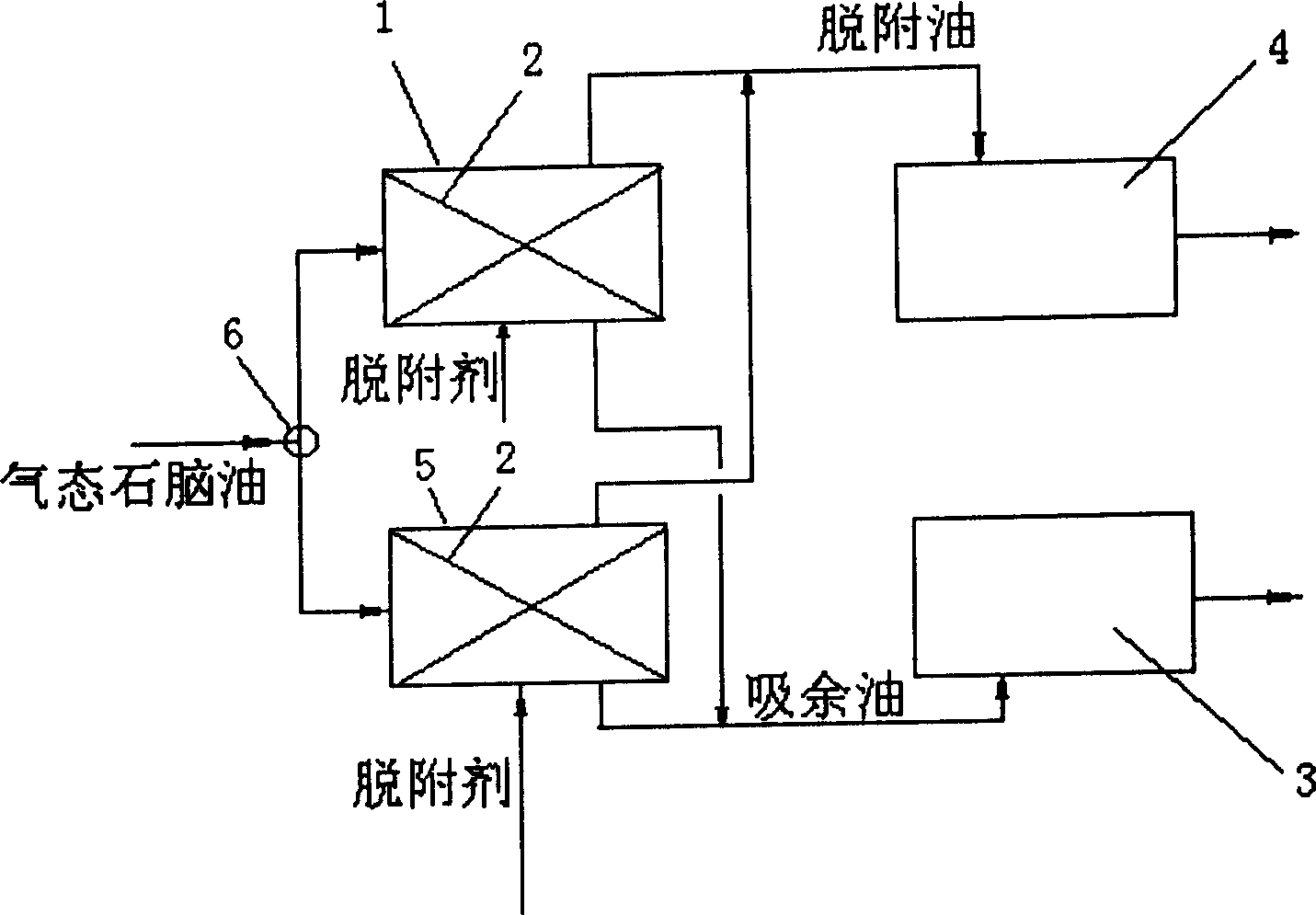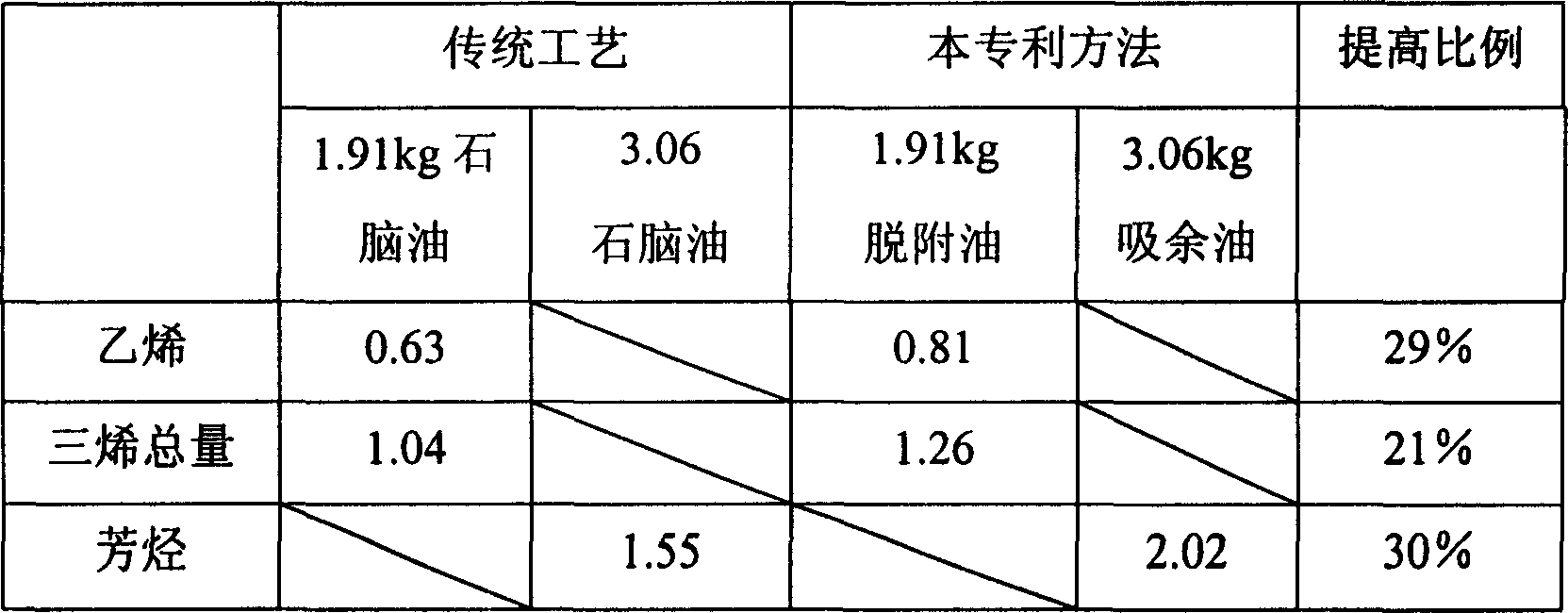Naphtha optimized utilization method
A naphtha, fixed bed adsorption technology, applied in the petroleum industry, refined hydrocarbon oil, etc., can solve the problems of difficult to achieve the level of clear separation of molecular management, reduced economic efficiency, low ethylene yield, etc., and achieve the extension of continuous operation cycle , reduce the cost of desorption, and reduce the one-time investment of equipment
- Summary
- Abstract
- Description
- Claims
- Application Information
AI Technical Summary
Problems solved by technology
Method used
Image
Examples
Embodiment 1
[0045] Straight-run naphtha with a distillation range of 50-180°C containing a mass concentration of 26.50% normal paraffins is vaporized and heated to 200°C, and the feed flow rate of the naphtha is 6kg / hour; it passes through a fixed-bed molecular sieve at a temperature of 200°C bed, 20kg5A molecular sieves are filled in the bed, the bed height is 100cm, the aspect ratio is 6: 1, the adsorption process is carried out for 30 minutes, and 2.11kg of absorption oil is obtained after condensation, and the yield is 70.4%. The alkane content is 0.30%.
[0046] After the adsorption process is over, use nitrogen to purge the bed for desorption. The nitrogen temperature is 400°C, the amount used is 1% of the naphtha treatment capacity, and the desorption time is 1 minute. The desorption airflow from the bed passes through the condenser And gas-liquid separator, obtain 0.13kg intermediate oil, yield is 4.3%, and the normal paraffin concentration in the intermediate oil is 40.1%.
[00...
Embodiment 2
[0053] Straight-run naphtha with a distillation range of 60-180°C containing a mass concentration of 26.50% normal paraffins is vaporized and heated to 200°C, and the feed flow rate of the naphtha is 6kg / hour; it passes through a fixed-bed molecular sieve at a temperature of 200°C bed, 20kg5A molecular sieves are filled in the bed, the bed height is 100cm, the aspect ratio is 6: 1, the adsorption process is carried out for 30 minutes, and 2.10kg of residual oil is obtained after condensation, and the yield is 70.3%. The alkane content is 0.30%.
[0054] After the adsorption process is over, use nitrogen to purge the bed for desorption. The nitrogen temperature is 400°C, the amount used is 10% of the naphtha treatment capacity, and the desorption time is 30 minutes. The desorption airflow from the bed passes through the condenser and a gas-liquid separator to obtain 0.87 kg of desorbed oil with a yield of 29.1%, and the content of normal paraffins in the desorbed oil is 90.4%. ...
Embodiment 3
[0059] Straight-run naphtha with a distillation range of 50-200°C containing 39.43% normal alkanes is vaporized and heated to 400°C, and the feed flow rate of naphtha is 10kg / hour; it passes through a fixed-bed molecular sieve at a temperature of 400°C bed, 30kg5A molecular sieves are filled in the bed, the bed height is 200cm, and the aspect ratio is 15:1. The adsorption process is carried out for 30 minutes, and 2.86kg of absorption oil is obtained after condensation, and the yield is 57.2%. The alkane content was 1.2%.
[0060] After the adsorption process is over, use nitrogen to purge the bed for desorption. The nitrogen temperature is 350°C, the amount used is 10% of the naphtha treatment capacity, and the desorption time is 40 minutes. The desorption airflow from the bed passes through the condenser and a gas-liquid separator to obtain 2.12 kg of desorbed oil with a yield of 42.3%, and the content of normal paraffins in the desorbed oil is 91.6%. Nitrogen is recycled. ...
PUM
 Login to View More
Login to View More Abstract
Description
Claims
Application Information
 Login to View More
Login to View More - R&D
- Intellectual Property
- Life Sciences
- Materials
- Tech Scout
- Unparalleled Data Quality
- Higher Quality Content
- 60% Fewer Hallucinations
Browse by: Latest US Patents, China's latest patents, Technical Efficacy Thesaurus, Application Domain, Technology Topic, Popular Technical Reports.
© 2025 PatSnap. All rights reserved.Legal|Privacy policy|Modern Slavery Act Transparency Statement|Sitemap|About US| Contact US: help@patsnap.com


